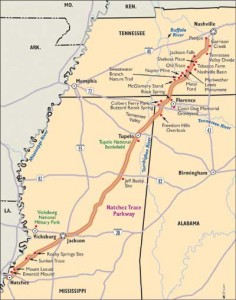The Natchez Trace Parkway between Nashville, Tennessee, and Tupelo, Mississippi, seems like a natural route for bicyclists traveling between the country music capital and the birthplace of Elvis.
Of course there are many other reasons to travel the 444-mile route across Tennessee, Alabama and Mississippi. Among them is the fact that the parkway is designated a bicycle route by the National Park for its entire route and commercial traffic — trucks — are prohibited.
Even so, many cyclists avoid this route, citing safety concerns.
Now the National Park Service and Adventure Cycling Association are studying ways to make the route safer.
According to WTVA in Tupelo, a pilot program will begin in the late summer of 2014 that will raise motorists’ awareness to bicyclists.
They plan to use more signage and other methods on two sections of parkway — one rural and one urban. Natchez Trace Parkway Superintendent Mary Risser says most of the bicycle fatalities over the years have been on rural sections of the parkway.
The parkway is designated as a bicycle route for its entire length. Although trucks are banned from the route, the speed limit for cars is 50 mph and there is no shoulder.
As Tupelo bike shop Bicycle Pacelines, owner Brian Piazza notes that the parkway is narrow and cars are bigger now.
The Old Natchez Trace served as a commerce route between the Mississippi River and central Tennessee from prehistoric times into the early 1800s. The trail served as a trade route for Native Americans and was later upgraded as a wagon road for settlers and traders.
Construction on the modern Natchez Trace Parkway began in the 1939, and continued in fits and starts into the 1990s. The last missing link was opened in 2005.
Encourage and warn
The National Park Service encourages bicyclists to use the Parkway, although it warns cyclists away from two sections during morning and evening commute hours: “Clinton to Ridgeland, Mississippi, Milepost 87-103, from 7:00-9:00 a.m.and from 4:00-6:00 p.m.and Tupelo, Mississippi, Mileposts 258-268, from 7:00-8:30 a.m. and 3:00-5:00 p.m. on weekdays.”
There are numerous campgrounds along the parkway, including five bicycle-only campgrounds. Also fresh water and restroom facilities are available every 20 miles along the Parkway.
Back in the 1980s, I biked and camped along the Natchez Trace Parkway for several days. I don’t remember any problems with traffic during the early summer bike tour. Except for another camper at the Meriwether Lewis Campground (the site of an inn where the explorer committed suicide), I don’t remember seeing another cyclist.
Today there’s a website devoted to Bicycling the Natchez Trace Parkway. It lists 10 reasons why the Parkway is an awesome bicycle route and has maps of the parkway, lists of campgrounds, bike shops and food stops along the route.
The National Park Service Bicycling on the Parkway webpage also lists rules of the road for bicyclists, camping information, and more.
There also are several guidebooks for bicycle travel on the parkway.



6 comments
Skip to comment form
I biked 115 miles of the trace a couple of years ago in one day. I had at least six near death experiences while on the trace. Even had one National park truck go by me at approx. 70 mph. The people in north Mississippi use this road as a mini interstate to get around at all times of the day at high speed. The parkway was not put there for locals to use a commuter highway. Until they limit the traffic and the speed, it will not be safe for bicyclists.
After spending two harrowing days of heavy vehicle traffic on trace we resorted to the back roads.
The Natchez Trace is a Motorized Carriageway, not a bike path or a hiking trail.
A large portion of the road has trees overhanging which create lengthy areas of shadows.
A bicyclist is a very small visual target.
When a motorist comes out of bright Sun light into dark shadows which are concealing a bicyclist, with a legal closing speed of forty miles per hour or more, (50 mph speed limit), with eyes which haven’t dilated to adjust to the shadowy darkness; the result is inevitable. The potential result should be obvious to all but morons.
Bicycling on Interstate Highways isn’t permitted for the same reason.
People are going to be seriously hurt and killed doing something this road was never intended to be used for.
During the Summer months the traffic can be fantastically heavy which only serves exacerbates the situation.
We need responsible legislators to step up and outlaw bicycling on the Natchez Trace before a massive tragedy occurs.
Or, instead we could outlaw idiots driving insane speeds. It’s illegal to drive faster than is safe for conditions, and if there are high contrast bright and dark shadow areas, then you need to slow down, perhaps even *gasp* below the speed limit.
The Trace is a recreational road, not meant for commuters or commercial traffic.
Hey captain, ” the parkway is designated a bicycle route by the National Park for its entire route”. I think a better solution to outlawing bicycling on the trace would be to educate those moron motorists.
The Natchez trace is a national park intended for recreation, not for getting from here to there as fast as possible. Having said that, I would add that it is too narrow for cars and bikes to happily coexist unless the speed limit were lowered to 20 mph and actively enforced. That would be an excellent solution and would serve the purpose for which the park was established. Barring that, maybe Trumps infrastructure plan could include a bicycle lane.